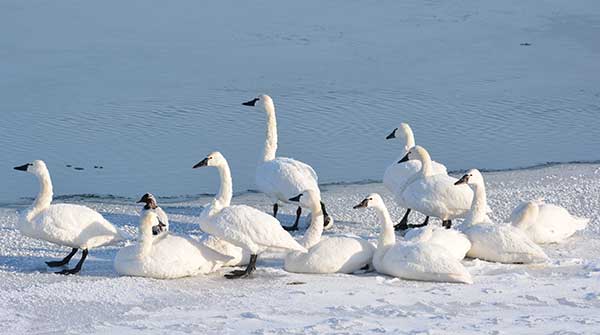While we may have warm blankets to keep us warm, birds only have their feathers
 Any animal, big or small, has to figure out how to stay warm in winter. At this time of year, we watch our feathered friends in awe as they wake up on the coldest mornings healthy and alive.
Any animal, big or small, has to figure out how to stay warm in winter. At this time of year, we watch our feathered friends in awe as they wake up on the coldest mornings healthy and alive.
Some birds have figured out survival techniques like searching out micro-climates. Starlings are known to cuddle up to a warm chimney and take advantage of the radiant heat. Bluebirds will crowd into a nest box on the coldest nights and share the body heat they all produce. Chickadees will snuggle deep inside a conifer tree, and woodpeckers will enter an old nest hole where the ambient temperature might be several degrees warmer than the unsheltered areas. These actions can reduce their heat loss by up to 50 percent in some cases.
Several biological mechanisms are in place to ensure survival. Respiration can be controlled to offset the influences of cold temperatures. For example, the blood flow to birds’ appendages is reduced during colder periods. In order to protect their core organs, the air sacs in their lungs trap more oxygen and increase their insulating effect.
 |
| Related Stories |
| Is nature really out to get us?
|
| The power of the crowd has an impact on nature
|
| Who doesn’t want to eat a meadow vole?
|
When it is too hot, birds pant and lift their wings so cool air can be brought into the lungs to help them deal with higher temperatures. Blood flowing over the poorly feathered underside of the wings also helps cool them. So when they want to stay warm, they just keep their wings tight against their bodies and keep their beaks shut!
While we may have warm blankets to keep us warm, birds only have their feathers. Birds that spend the winter in colder climes actually have more feathers in the winter than in the summer. For example, Carolina Chickadees wintering in Georgia might only have 1,140 feathers, but ours have 1,700 in the winter.
Our birds gradually shed the excess feathers in the spring, losing about 600 by June. This is a unique means of thermoregulation. Birds that don’t spend the winter here undergo a full moult and regrow all their feathers at once, so they can get on with the business of migration. However, non-migratory northern species will only develop some of their feathers in the fall and gradually add more in response to declining temperatures. This again ensures they can regulate their body temperature in direct response to the local environment. So if you think winter birds look “fatter,” they are!
Birds will assume a spherical posture to reduce their surface area and fluff out their feathers in colder weather to trap more heat in the insulating layers above the skin. Many will also tuck their feet into their feathers when roosting or at least stand on one foot at a time. This can reduce heat loss by as much as 12 percent over normal posturing birds.
Ducks and other waterfowl must keep their skin dry so they use two mechanisms: First, they have tightly and densely packed feathers that trap air and don’t allow cold water to penetrate. Second, they have a uropygial gland from which they extract oils to further waterproof their feathers.
Perhaps the most unique and complicated defence against cold is keeping their feet warm, particularly when we think of waterfowl and their kin. Imagine an unfeathered and unprotected leg or foot underwater when the outside temperature hovers well below freezing. Blood flow to the legs is regulated such that the farther down the leg (i.e. tarsi) of the bird one goes, the closer the skin is to ambient temperatures in cold climes. The temperature of the toes essentially equals the ambient environmental temperature.
Complex mechanisms that deal with blood flow through the arteries or veins regulate the surface temperature of the unfeathered parts of the body in a unique heat exchange process, ensuring the bird’s survival. Higher up the leg, the temperature gradually increases to the point where the feathered tarsi are approximately the same as the bird’s core temperature.
So however you look at it, birds are amazing at adapting to a changing environment and can survive the coldest periods when we all might perish.
Geoff Carpentier is a published author, expedition guide and environmental consultant. Visit Geoff on LinkedIn, Instagram and Facebook.
For interview requests, click here.
The opinions expressed by our columnists and contributors are theirs alone and do not inherently or expressly reflect the views of our publication.
© Troy Media
Troy Media is an editorial content provider to media outlets and its own hosted community news outlets across Canada.

